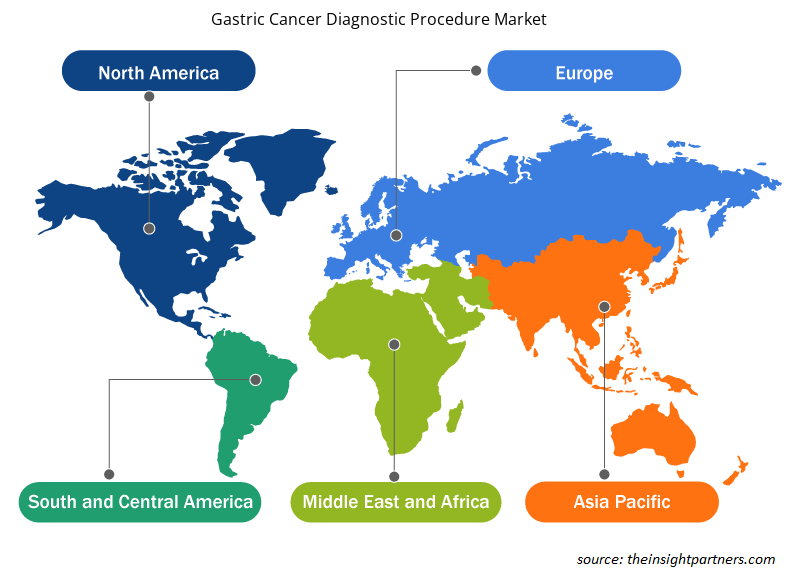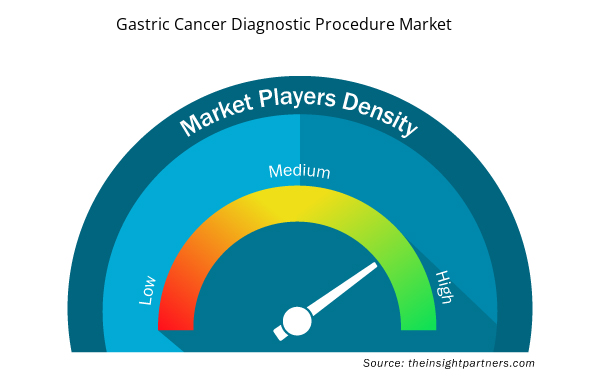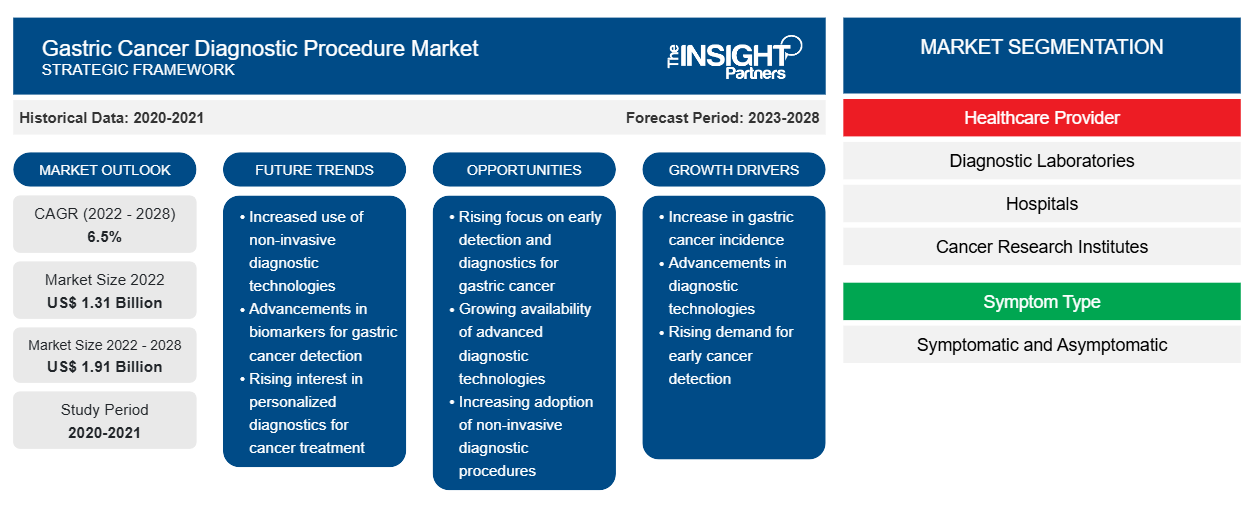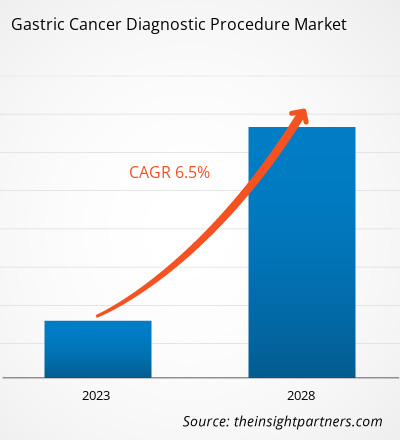胃癌诊断程序市场预计将从 2022 年的 13.0796 亿美元增长到 2028 年的 19.1203 亿美元;预计 2022 年至 2028 年的复合年增长率为 6.5%。
胃癌诊断程序市场根据医疗保健提供者、症状类型、体液、程序、产品、疾病指征和地理位置进行细分。该报告提供了对市场的见解和深入分析,强调了胃癌诊断程序市场的动态、趋势和机会等参数,以及各地区主要市场参与者的竞争格局分析。它还包括 COVID-19 大流行对这些地区市场的影响分析。
定制此报告以满足您的需求
您可以免费定制任何报告,包括本报告的部分内容、国家级分析、Excel 数据包,以及为初创企业和大学提供优惠和折扣
- 获取此报告的关键市场趋势。这个免费样品将包括数据分析,从市场趋势到估计和预测。
市场洞察
胃肠道疾病患病率上升
尽管近几十年来胃癌的发病率和死亡率有所下降,但胃癌仍被视为全球主要的健康挑战之一。根据 GLOBOCAN 的数据,2020 年胃癌导致约 800,000 人死亡(占所有癌症相关死亡的 7.7%)。该疾病是男女癌症死亡的第四大原因。2020 年诊断出约 110 万例新胃癌病例,占所有癌症病例的 5.6%。亚洲占全球报告的新胃癌病例和死亡人数的约 75%。美国和加拿大等西方国家报告的胃肠道疾病发病率很高,这可以归因于成年人口肥胖增加和膳食纤维摄入减少。根据美国疾病控制和预防中心 2022 年 12 月发布的数据,美国医生办公室记录了约 3720 万例消化系统疾病。
近几十年来,肠易激综合征 (IBS) 的发病率在世界范围内不断上升。根据国际胃肠病基金会的数据,IBS 是最常见的功能性胃肠道疾病,全球发病率为 10-15%。此外,美国医生每年记录的 IBS 患者就诊量约为 240-350 万。尽管近年来胃癌的总体发病率一直在下降,但过去几十年来,年轻人的胃癌发病率却大幅上升。因此,胃肠道 (GI) 疾病的发病率不断上升导致罹患胃癌的风险很高,从而推动了胃癌诊断程序市场的增长。
基于医疗保健提供者的见解
根据医疗保健提供商,全球胃癌诊断程序市场分为诊断实验室、医院、癌症研究机构、肿瘤专科诊所等。2022 年,医院部门占据了最大的市场份额。预计在预测期内,癌症研究机构部门的市场将以最高的复合年增长率增长。
基于症状类型的见解
根据症状类型,胃癌诊断程序市场分为有症状和无症状两类。2022 年,无症状部分占据了更大的市场份额。然而,预计有症状部分在预测期内的复合年增长率会更高。
基于体液的见解
根据体液,胃癌诊断程序市场细分为血液、尿液、唾液、胃冲洗液/胃液、组织和其他。2022 年,血液部分占据最大的市场份额。然而,预计组织部分的市场在预测期内将以最快的复合年增长率增长。
基于流程的洞察
根据程序,胃癌诊断程序市场细分为内窥镜检查、活检和组织测试、实验室测试、体外诊断测试、影像测试、分子诊断、多路复用分子诊断和免疫测定等。2022 年,影像测试部分占据最大的市场份额。预计活检和组织测试部分的市场在预测期内将实现更高的复合年增长率。
基于产品的洞察
根据产品,胃癌诊断程序市场分为仪器、试剂和耗材以及服务。2022 年,试剂和耗材部分占据了最大的市场份额。预计服务部分市场在预测期内的复合年增长率会更高。
基于疾病指征的见解
根据疾病指征,胃癌诊断程序市场分为早期胃癌和晚期胃癌。2022 年,晚期胃癌细分市场占据了更大的市场份额。预计同一细分市场的市场在预测期内将以更高的复合年增长率增长。
COVID-19 洞察
为减少 SARS-CoV-2 的传播,一些国家实施了预防措施,例如刻意扩大物理空间以避免密切接触和疾病传播,以及强制在工作场所使用口罩。然而,各种限制导致胃癌诊断和治疗的预约被取消或重新安排。根据 2021 年在 PubMed 上发表的一项研究,在 COVID-19 期间,被诊断出患有 I 期胃癌和结直肠癌的患者数量明显减少。2020 年第一季度后,政府和私人机构对 COVID-19 患者进行幽门螺杆菌感染检测的胃癌诊断需求增加。此外,晚期胃癌患者被优先诊断和治疗,这导致 COVID-19 危机期间胃癌诊断程序市场增长。
胃癌诊断程序市场区域洞察
Insight Partners 的分析师已详尽解释了预测期内影响胃癌诊断程序市场的区域趋势和因素。本节还讨论了北美、欧洲、亚太地区、中东和非洲以及南美和中美洲的胃癌诊断程序市场细分和地理位置。

- 获取胃癌诊断程序市场的区域特定数据
胃癌诊断程序市场报告范围
| 报告属性 | 细节 |
|---|---|
| 2022 年市场规模 | 13.1亿美元 |
| 2028 年市场规模 | 19.1亿美元 |
| 全球复合年增长率(2022 - 2028) | 6.5% |
| 史料 | 2020-2021 |
| 预测期 | 2023-2028 |
| 涵盖的领域 | 按医疗保健提供者
|
| 覆盖地区和国家 | 北美
|
| 市场领导者和主要公司简介 |
|
胃癌诊断程序市场参与者密度:了解其对业务动态的影响
胃癌诊断程序市场正在快速增长,这得益于终端用户需求的不断增长,而这些需求又源于消费者偏好的不断变化、技术进步以及对产品优势的认识不断提高等因素。随着需求的增加,企业正在扩大其产品范围,进行创新以满足消费者的需求,并利用新兴趋势,从而进一步推动市场增长。
市场参与者密度是指在特定市场或行业内运营的企业或公司的分布情况。它表明在给定市场空间中,相对于其规模或总市场价值,有多少竞争对手(市场参与者)存在。
在胃癌诊断程序市场运营的主要公司有:
- 亚特拉斯联生物科技股份有限公司
- Bio-Rad 实验室公司
- MiRXES 私人有限公司
- 安捷伦科技公司
- F. 霍夫曼-罗氏有限公司
免责声明:上面列出的公司没有按照任何特定顺序排列。

- 了解胃癌诊断程序市场顶级关键参与者概述
胃癌诊断程序市场参与者采用产品发布和扩张等有机策略来扩大其全球足迹和产品组合并满足不断增长的需求。合作伙伴关系和协作是市场上见证的无机增长战略之一。这些增长战略使市场参与者能够扩大业务并增强其地理影响力。此外,收购、合作伙伴关系和其他增长战略有助于公司加强客户群并增加其产品组合。
- 2023 年 2 月,CARsgen Therapeutics 宣布与 F. Hoffmann-La Roche(罗氏)达成合作协议,以评估 AB011 和阿替利珠单抗治疗胃癌的效果。此次合作将评估 CARsgen 的试验药物 AB011、罗氏的 PD-L1 检查点抑制剂阿替利珠单抗以及标准化疗组合在胃癌或胃食管交界处癌患者中的疗效。
- 2023 年 1 月,安捷伦科技宣布与 Akoya Biosciences 合作,为致力于开发精准癌症疗法的生物制药公司开发包括空间分析在内的显色和免疫荧光多重检测。此次合作建立了一个生态系统,有助于开发新型精准癌症疗法,并为这两家公司在临床研究市场的客户提供简化的工作流程。
- 2022 年 8 月,MiRXES 推出了一系列新功能,包括工业 4.0 制造工厂、两个新实验室和一个合作的多癌症筛查研究项目。这些新发展符合 MiRXES 的目标,即提高其研究和生产能力,开发基于 miRNA 的疾病检测测试。
- 2022年7月,MiRXES Pte Ltd启动了全球首个大型临床研究项目——CADENCE(CAncer Detected Early caN be CurEd)。CADENCE项目旨在开发一种针对多达九种高发病率和高死亡率癌症的多癌种早期检测测试:肺癌、乳腺癌、结直肠癌、肝癌、胃癌、食道癌、卵巢癌、胰腺癌和前列腺癌。
胃癌诊断程序市场 - 公司简介
- 亚特拉斯联生物科技股份有限公司
- Bio-Rad 实验室公司
- MiRXES 私人有限公司
- 安捷伦科技公司
- F. 霍夫曼-罗氏有限公司
- 生物梅里埃公司
- 赛默飞世尔科技公司
- Illumina公司
- Vela Diagnostics 控股私人有限公司
- Myraid 基因公司
- 历史分析(2 年)、基准年、预测(7 年)及复合年增长率
- PEST 和 SWOT 分析
- 市场规模价值/数量 - 全球、区域、国家
- 行业和竞争格局
- Excel 数据集



Report Coverage
Revenue forecast, Company Analysis, Industry landscape, Growth factors, and Trends

Segment Covered
This text is related
to segments covered.

Regional Scope
North America, Europe, Asia Pacific, Middle East & Africa, South & Central America

Country Scope
This text is related
to country scope.
常见问题
The factors that are driving the growth of the gastric cancer diagnostic procedure market are the rise in alcohol consumption, smoking, surging cases of Helicobacter pylori infection, and the rise in the prevalence of gastrointestinal diseases. These are some of the major factors contributing to the growth of the gastric cancer diagnostic procedure industry.
Gastric cancer is a type of malignant cancer that forms the stomach's inner lining. Risk factors such as age, diet, and stomach diseases can lead to the development of gastric cancer. Symptoms of gastric cancer include indigestion, heartburn, bloating, and stomach discomfort or pain.
The gastric cancer diagnostic procedure market majorly consists of the players, such as Atlas-Link Biotech Co Ltd, Bio-Rad Laboratories Inc, MiRXES Pte Ltd, Agilent Technologies Inc, F. Hoffmann-La Roche Ltd, bioMerieux SA, Thermo Fisher Scientific Inc, Illumina Inc, Vela Diagnostics Holding Pte Ltd, and Myraid Genetics Inc.
The gastric cancer diagnostic procedure market is estimated to be valued at US$ 1307.96 million in 2022.
The CAGR value of the gastric cancer diagnostic procedure market during the forecasted period is 6.5%%.
The Asia Pacific is expected to be the fastest-growing region in the gastric cancer diagnostic procedure market over the forecast period due to the increasing surging cases of helicobacter pylori infection and the rise in the prevalence of gastrointestinal diseases.
The gastric cancer diagnostic procedure market is expected to be valued at US$ 1912.03 million by 2028.
The hospitals segment held the largest share of the market in 2022. Also, the cancer research institutes segment is estimated to register the highest CAGR in the market during the forecast period.
Trends and growth analysis reports related to Life Sciences : READ MORE..
The List of Companies - Gastric Cancer Diagnostic Procedure Market
- Atlas-Link Biotech Co Ltd
- Bio-Rad Laboratories Inc
- MiRXES Pte Ltd
- Agilent Technologies Inc
- F. Hoffmann-La Roche Ltd
- bioMerieux SA
- Thermo Fisher Scientific Inc
- Illumina Inc
- Vela Diagnostics Holding Pte Ltd
- Myraid Genetics Inc.
The Insight Partners performs research in 4 major stages: Data Collection & Secondary Research, Primary Research, Data Analysis and Data Triangulation & Final Review.
- Data Collection and Secondary Research:
As a market research and consulting firm operating from a decade, we have published and advised several client across the globe. First step for any study will start with an assessment of currently available data and insights from existing reports. Further, historical and current market information is collected from Investor Presentations, Annual Reports, SEC Filings, etc., and other information related to company’s performance and market positioning are gathered from Paid Databases (Factiva, Hoovers, and Reuters) and various other publications available in public domain.
Several associations trade associates, technical forums, institutes, societies and organization are accessed to gain technical as well as market related insights through their publications such as research papers, blogs and press releases related to the studies are referred to get cues about the market. Further, white papers, journals, magazines, and other news articles published in last 3 years are scrutinized and analyzed to understand the current market trends.
- Primary Research:
The primarily interview analysis comprise of data obtained from industry participants interview and answers to survey questions gathered by in-house primary team.
For primary research, interviews are conducted with industry experts/CEOs/Marketing Managers/VPs/Subject Matter Experts from both demand and supply side to get a 360-degree view of the market. The primary team conducts several interviews based on the complexity of the markets to understand the various market trends and dynamics which makes research more credible and precise.
A typical research interview fulfils the following functions:
- Provides first-hand information on the market size, market trends, growth trends, competitive landscape, and outlook
- Validates and strengthens in-house secondary research findings
- Develops the analysis team’s expertise and market understanding
Primary research involves email interactions and telephone interviews for each market, category, segment, and sub-segment across geographies. The participants who typically take part in such a process include, but are not limited to:
- Industry participants: VPs, business development managers, market intelligence managers and national sales managers
- Outside experts: Valuation experts, research analysts and key opinion leaders specializing in the electronics and semiconductor industry.
Below is the breakup of our primary respondents by company, designation, and region:

Once we receive the confirmation from primary research sources or primary respondents, we finalize the base year market estimation and forecast the data as per the macroeconomic and microeconomic factors assessed during data collection.
- Data Analysis:
Once data is validated through both secondary as well as primary respondents, we finalize the market estimations by hypothesis formulation and factor analysis at regional and country level.
- Macro-Economic Factor Analysis:
We analyse macroeconomic indicators such the gross domestic product (GDP), increase in the demand for goods and services across industries, technological advancement, regional economic growth, governmental policies, the influence of COVID-19, PEST analysis, and other aspects. This analysis aids in setting benchmarks for various nations/regions and approximating market splits. Additionally, the general trend of the aforementioned components aid in determining the market's development possibilities.
- Country Level Data:
Various factors that are especially aligned to the country are taken into account to determine the market size for a certain area and country, including the presence of vendors, such as headquarters and offices, the country's GDP, demand patterns, and industry growth. To comprehend the market dynamics for the nation, a number of growth variables, inhibitors, application areas, and current market trends are researched. The aforementioned elements aid in determining the country's overall market's growth potential.
- Company Profile:
The “Table of Contents” is formulated by listing and analyzing more than 25 - 30 companies operating in the market ecosystem across geographies. However, we profile only 10 companies as a standard practice in our syndicate reports. These 10 companies comprise leading, emerging, and regional players. Nonetheless, our analysis is not restricted to the 10 listed companies, we also analyze other companies present in the market to develop a holistic view and understand the prevailing trends. The “Company Profiles” section in the report covers key facts, business description, products & services, financial information, SWOT analysis, and key developments. The financial information presented is extracted from the annual reports and official documents of the publicly listed companies. Upon collecting the information for the sections of respective companies, we verify them via various primary sources and then compile the data in respective company profiles. The company level information helps us in deriving the base number as well as in forecasting the market size.
- Developing Base Number:
Aggregation of sales statistics (2020-2022) and macro-economic factor, and other secondary and primary research insights are utilized to arrive at base number and related market shares for 2022. The data gaps are identified in this step and relevant market data is analyzed, collected from paid primary interviews or databases. On finalizing the base year market size, forecasts are developed on the basis of macro-economic, industry and market growth factors and company level analysis.
- Data Triangulation and Final Review:
The market findings and base year market size calculations are validated from supply as well as demand side. Demand side validations are based on macro-economic factor analysis and benchmarks for respective regions and countries. In case of supply side validations, revenues of major companies are estimated (in case not available) based on industry benchmark, approximate number of employees, product portfolio, and primary interviews revenues are gathered. Further revenue from target product/service segment is assessed to avoid overshooting of market statistics. In case of heavy deviations between supply and demand side values, all thes steps are repeated to achieve synchronization.
We follow an iterative model, wherein we share our research findings with Subject Matter Experts (SME’s) and Key Opinion Leaders (KOLs) until consensus view of the market is not formulated – this model negates any drastic deviation in the opinions of experts. Only validated and universally acceptable research findings are quoted in our reports.
We have important check points that we use to validate our research findings – which we call – data triangulation, where we validate the information, we generate from secondary sources with primary interviews and then we re-validate with our internal data bases and Subject matter experts. This comprehensive model enables us to deliver high quality, reliable data in shortest possible time.


 获取此报告的免费样本
获取此报告的免费样本